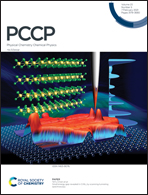Microsolvation of Zn cations: infrared multiple photon dissociation spectroscopy of Zn+(H2O)n (n = 2–35)†
Abstract
The structures, along with solvation evolution, of size-selected Zn+(H2O)n (n = 2–35) complexes have been determined by combining infrared multiple photon photodissociation (IRMPD) spectroscopy and density functional theory. The infrared spectra were recorded in the O–H stretching region, revealing varying shifts in band position due to different water binding motifs. Concordant with previous studies, a coordination number of 3 is observed, determined by the sudden appearance of a broad, red-shifted band in the hydrogen bonding region for clusters n > 3. The coordination number of 3 seems to be retained even for the larger clusters, due to incoming ligands experiencing significant repulsion from the Zn+ valence 4s electron. Evidence of spectrally distinct single- and double-acceptor sites are presented for medium-sized clusters, 4 ≤ n ≤ 7, however for larger clusters, n ≥ 8, the hydrogen bonding region is dominated by a broad, unresolved band, indicative of the increased number of second and third coordination sphere ligands. No evidence of a solvated, six-fold coordinated Zn2+ ion/solvated electron pair is present in the spectra.



 Please wait while we load your content...
Please wait while we load your content...